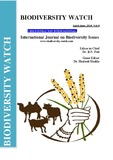| dc.contributor.author | Happychuk, Naomi | |
| dc.contributor.author | Palikhey, Epsha | |
| dc.contributor.author | Lama, Laxmi | |
| dc.contributor.author | Sthapit, Sajal | |
| dc.contributor.author | Shukla, Shailesh | |
| dc.date.accessioned | 2015-11-13T16:35:26Z | |
| dc.date.available | 2015-11-13T16:35:26Z | |
| dc.date.issued | 2014-06 | |
| dc.identifier.citation | Happychuk, Naomi, Epsha Palikhey, Laxmi Lama, Sajal Sthapit, and Shailesh Shukla. "Reacquiring a taste for Diversity: Changing food habits, their casual factors, and the value of dietary diversity in Jumla, Nepal." Biodiversity Watch, 4 (April-June 2014): 167-197. | |
| dc.identifier.uri | http://hdl.handle.net/10680/899 | |
| dc.description.abstract | Understanding local food systems including food habit changes and the factors contributing to these changes is critical to ensuring effective interventions of food security. While diversity of foods is widely recognized as an important aspect of sustainable diets and food security, the value people place on dietary diversity is rarely considered in local interventions. In the remote, high-hill district of Jumla in Nepal, diversity is particularly important for food security. Despite this, many people choose to eat the same meal of dalbhat twice a day, leaving to question the value they have for dietary diversity. This has implications for the interventions used by policymakers and practitioners to address issues of food insecurity. This study examines community-perceived food habit changes and the factors contributing to these changes in Jumla, in addition to the value people place on dietary diversity. A participatory research approach employing eight focus group discussions was used to elicit and examine community perceptions. A variety of causal factors were cited as responsible for changes in both consumption and production of food over the past sixty years, particularly the onset of pests and diseases, the effects of climate change, and food aid. While access and availability pose major barriers to dietary diversity in Jumla, persistent food habits were found to underlie consumption patterns. It is therefore necessary that the production and markets for local foods are enhanced, development and food security are planned collectively, and new cooking methods and recipes are promoted to enable people to reacquire a taste for diversity. | en_US |
| dc.language | en | |
| dc.publisher | Biodiversity Watch | en_US |
| dc.rights | info:eu-repo/semantics/openAccess | |
| dc.subject | Biodiversity | en_US |
| dc.title | Reacquiring a taste for Diversity: Changing food habits, their casual factors, and the value of dietary diversity in Jumla, Nepal | en_US |
| dc.type | Article | en_US |

